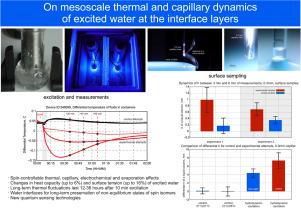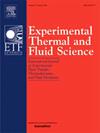Thermal and capillary behavior of water at interfaces under excitation
IF 3.3
2区 工程技术
Q2 ENGINEERING, MECHANICAL
Experimental Thermal and Fluid Science
Pub Date : 2025-07-23
DOI:10.1016/j.expthermflusci.2025.111565
引用次数: 0
Abstract
Previous publications have demonstrated changes of electrochemical reactivity, proton density and evaporation rate of water excited by hydrodynamic cavitation and weak magnetic fields. Proposed explanation of these effects concerns spin-based mechanisms at water–air interfaces, which are of significant technological interest. Following these ideas, we also expect changes in heat capacity and surface tension of excited water. This work provides experimental evidences for these assumptions and describes experiments on capillary effects and thermal dynamics of pure H2O with focus on hydrodynamic cavitation. Experiments use two calorimetric systems for diathermic measurements and 0.3 mm/0.5 mm capillary tubes. Samples after excitation are degassed at -0.09MPa and thermally equalized in a water bath. Given the critical role of water–air interfaces in these phenomena, a micromanipulation tool was used to sample from the 0.1 mm subsurface layer, with comparisons made to immersion depths of 2 mm and 10 mm. Conducted attempts demonstrated changes in heat capacity of 4.17%–5.72% within 60 min after excitation, decreasing to 2.08% in steady-state dynamics. The surface tension varied between control and experimental samples by 6.7%–11.3% with a maximum of 15.7%. Effects in near-surface layers last for 30-60 min after the excitation. These outcomes are consistent with the results of NMR and four-photon spectroscopy conducted earlier. The described approach can be used for the rapid detection of spin-based phenomena. Given the importance of capillary and electrochemical processes in aquaporin channels and plant fluid transport systems, these techniques hold promise for applications in phytosensing and agricultural production.

激发下界面处水的热和毛细行为
以前的文章已经证明了水在流体动力空化和弱磁场激发下的电化学反应性、质子密度和蒸发速率的变化。对这些效应提出的解释涉及水-空气界面的自旋机制,这是一个重要的技术兴趣。根据这些想法,我们还期望激发水的热容和表面张力的变化。本文为这些假设提供了实验证据,并描述了纯水的毛细效应和热动力学实验,重点是水动力空化。实验使用两种热计系统进行透热测量和0.3 mm/0.5 mm毛细管。激发后的样品在-0.09MPa下脱气,并在水浴中热均衡。考虑到水-空气界面在这些现象中的关键作用,使用微操作工具从0.1 mm的次表层取样,并与2 mm和10 mm的浸泡深度进行比较。实验表明,在激励后60 min内,热容量的变化为4.17%-5.72%,在稳态动力学下下降至2.08%。对照和实验样品的表面张力变化幅度为6.7% ~ 11.3%,最大值为15.7%。激发后近表层的效应持续30-60分钟。这些结果与之前进行的核磁共振和四光子光谱的结果一致。所述方法可用于快速检测基于自旋的现象。鉴于毛细管和电化学过程在水通道蛋白通道和植物流体运输系统中的重要性,这些技术有望在植物传感和农业生产中得到应用。
本文章由计算机程序翻译,如有差异,请以英文原文为准。
求助全文
约1分钟内获得全文
求助全文
来源期刊

Experimental Thermal and Fluid Science
工程技术-工程:机械
CiteScore
6.70
自引率
3.10%
发文量
159
审稿时长
34 days
期刊介绍:
Experimental Thermal and Fluid Science provides a forum for research emphasizing experimental work that enhances fundamental understanding of heat transfer, thermodynamics, and fluid mechanics. In addition to the principal areas of research, the journal covers research results in related fields, including combined heat and mass transfer, flows with phase transition, micro- and nano-scale systems, multiphase flow, combustion, radiative transfer, porous media, cryogenics, turbulence, and novel experimental techniques.
 求助内容:
求助内容: 应助结果提醒方式:
应助结果提醒方式:


